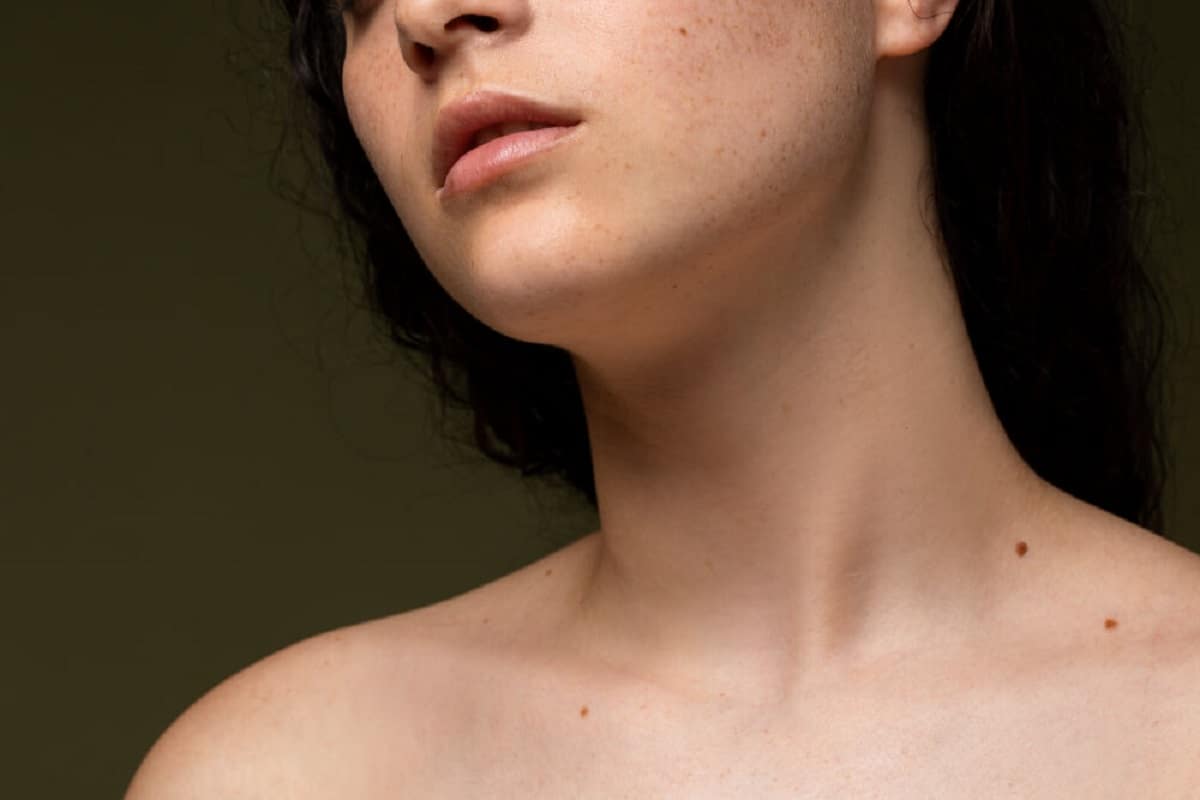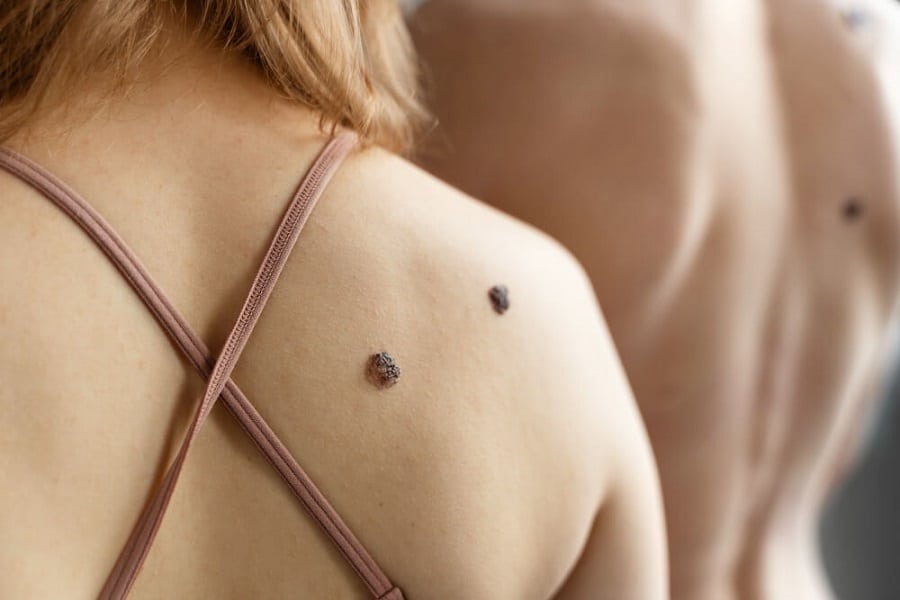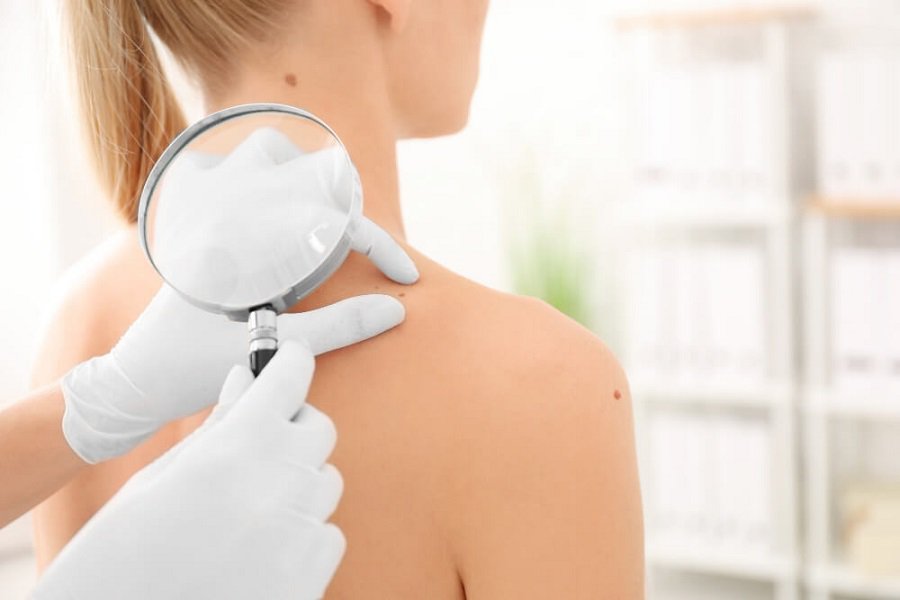Beauty Marks and Moles: What’s the Difference?
10th October, 2023

Beauty marks and moles have been concerning for people’s bodies for many years, whilst also maintaining some cultural significance in society, from Shakespeare to Marilyn Monroe. In this article, we will explore the difference between beauty marks and moles, how they can lead to skin cancer, and what you can do to prevent moles from getting worse.
What are Beauty Spots?
A beauty spot, or mark, often refers to a dark facial spot which is commonly seen to be attractive and appealing. Often, it can also be referred to as a mole, freckle, or birthmark that you’ve had since birth. Essentially, the phrase “beauty mark” is a term for any dark mark on the face, whether it’s a freckle or mole. In simple terms, beauty marks are moles.
Who has beauty spots?
As you learn about what are beauty marks and moles, you may realise that more people are likely to have them than those that don’t. People of all skin tones have beauty spots. Typically, those with lighter skin have around 20 across their whole body, while those with darker skin are likely to have fewer.
These spots vary in size and shade. While babies are often born without them, beauty spots usually appear as they grow older. Fortunately, if the number of beauty spots or marks across your body increases, it is not usually something to be overly concerned about.
Interesting facts about beauty spots
Here are some interesting facts that you may not know about beauty spots:
- Some people may not recognise that beauty marks are, in fact, moles, but the difference is that not all moles qualify as beauty marks. If it’s on the face, it’s often called a beauty mark; whereas, anywhere else on the body, it’s just a mole.
- While only 1% of babies are born with them, beauty marks can appear during childhood, teenage years, or even adulthood.
- Shakespeare appreciated beauty marks, even giving his character Imogen in Cymbeline one.
- Interestingly, only 1 in 100 people have a beauty mark.
- In the 18th century, women used mouse fur to cover smallpox scars, turning them into beauty marks. In fact, there has been a long history of beauty marks that you should also follow up on.
- The authenticity of Marilyn Monroe’s beauty marks have been debated for years, and reshaped the meaning behind beauty spots on the face. Some say she concealed it early in her career for roles. Yet, photos show its position changing from her cheek to her chin’s side. What do you think? Here is where you can leave more about the evolution of Marilyn Monroe’s beauty mark.
Can beauty spots make you sick?
Generally, beauty marks and moles are harmless, and many people won’t have problems with them. However, beauty spots can be over exaggerated when exposed to sunlight or UV rays which can cause these spots to turn cancerous. If so, have them examined every so often, ideally every three years, based on your age and skin health.
Are some people more threatened than others?
Skin cancer from mutating beauty spots can affect anyone, but three main factors influence its development:
Skin Colour: Light-skinned people are at a higher risk compared to those with darker skin.
Number of Beauty Spots: A greater number of spots can increase the chances of them turning malignant.
Geographic Location: Places with intense UV exposure, like Australia, see higher rates of skin cancer. In Australia, the majority of the population consists of light-skinned Anglo-Saxon immigrants. They often have a genetic tendency to have more beauty spots, and the region has strong UV radiation. Recognizing the severity, the Australian government banned tanning salons in January to combat the widespread skin cancer issue.
Beauty Mark vs. Mole: Exploring the Difference
By adulthood, it is considered normal for people to have between 10 and 40 moles across their bodies. The majority of moles appear during the first 20 years of life. Moles can have different colours, ranging from matching your natural skin tone to being brown or black. While some moles are harmless and common, there are specific types that should be a cause for concern.
3 Types Of Moles to Know

Three main types of moles exist, and two of them might turn into melanoma. It’s crucial to have them checked by a dermatologist.
- Common Nevi: These are typical moles. They’re small, often pink, tan, or brown, and have a clear shape.
- Congenital Nevi: Found in roughly 1% of people, these moles are present from birth and carry a higher melanoma risk as time goes on.
- Dysplastic Nevi: Often passed down in families, these moles are bigger than a pinhead, have a darker centre, and an irregular shape. These can lead to more people becoming prone to melanoma.
You can also keep your moles covered up with our tattoo cover up foundation.
What Causes a Mole?
Moles are caused when melanocytes grow in clusters around the skin. Over time, these can become darkened by sunlight exposure, puberty or even pregnancy. Moles are not always dark toned, however, and can appear light too. The average mole life cycle can last up to 50 years on the body, depending on whether they change colour, develop hairs, or even become raised.
Why You Should Do Regular Mole Checks
By regularly visiting a dermatologist will allow a higher chance for moles to be detected on the skin, and therefore be able to track and treat signs of melanoma sooner, as well as other skin cancers that can be provoked by this. But how can you be sure when a mole is a course for concern? It is recommended to do monthly checks, either by yourself or a dermatologist, to see if there has been any progress with your moles, including the increase of appearances or colour changes.
A Brief Look at Melanoma
While most moles are benign, any change in their appearance should be checked over by your GP. Whilst moles are unlikely to bring harm in the short term, there’s still a chance it could be melanoma. This skin cancer is also referred to as ‘malignant melanoma’ or ‘cutaneous melanoma.’ Since melanoma cells often produce pigment, the tumours typically appear brown or black. Excessive UV exposure is a common cause, but melanoma can form anywhere on the body. It frequently begins on men’s chests or backs and women’s legs. Although rarer than other skin cancers, melanoma is more perilous due to its ability to spread if not detected early.
To lower melanoma risks:
- Limit Sun Exposure: The sun’s rays are most potent between 10 AM and 4 PM. Plan outdoor activities outside these hours or during overcast days.
- Use Suncream: Apply broad-spectrum suncream with at least SPF 30, even on cloudy days, throughout the year.
- Dress Protectively: Opt for dark, tightly woven clothes that cover your limbs. Specialised protective clothing is available, and dermatologists can offer suggestions.
- Avoid Tanning Devices: Tanning lamps and beds emit harmful UV rays, raising skin cancer risks. Consider spray tans as a safer tanning alternative.
How to Do a Mole Check

To reassure yourself about what are beauty marks, moles, and to lessen the risks that they bring, follow these tips:
- Post-bath observation: Check your skin immediately after showering or bathing when it’s still damp for the clearest view. You can also follow guidance on how to do a self-skin examination.
- Look in the mirror: Use both a full-length and hand mirror for a detailed view of your moles. If needed, ask someone you trust to help inspect hard-to-see areas like your back.
- Regular checks: Adopt a systematic approach, starting from your head and moving down to your toes. Always be on the lookout for new moles or changes in existing ones.
- Inspect hidden areas: Don’t forget areas like your toes, fingers, groin, behind the ears, knee backs, and foot soles.
- Documentation: Take photos of your moles monthly. Date them and keep a regular check on them for future reference.
What to Look for When Checking Your Moles
As you learn about beauty spots vs moles, you will likely come across an industry term referred to as the ABCDE skin examination. These five factors contribute better towards your understanding of beauty marks and moles, and want potential signs of them on your body could lead to:
- A: Asymmetry: If your moles don’t match or change shape could be a sign of skin cancer.
- B: Border: Observe the borders of your moles to see if there are any blurred or uneven areas.
- C: Colour: If your moles have changed colour or tone, is a sign that skin cancer may be present. Therefore, visit your GP immediately.
- D: Diameter: Changes in mole sizes is another cause for concern.
- E: Elevation: If a mole has become raised, you should check this change with your GP or dermatologist.
Should I Be Worried About My Beauty Marks?
Over time, beauty marks and moles may naturally change colour, border, size, or overall appearance, which should be followed through from your ABCDE check. To determine the best approach, you should consult your GP if you have potential concerns to see if there are signs of skin cancer present from your moles.
How To Get Rid of Moles
Before opting for at-home removal methods, you should always consult a specialist first. Not only does this ensure your safety, but doctors can also test the removed tissue for melanoma. Removing a mole at home leaves you in the dark about its potential cancerous nature.
Risks of Common Techniques:
- Topical Pastes: These can trigger allergic skin reactions and often fail to effectively remove moles.
- Shaving: This method might leave mole remnants and potential scars. There’s also an infection risk.
- Tattooing Over Moles: This approach can obscure any mole changes, making them harder to find.
- Prioritise Safety: Schedule a visit with your dermatologist or GP. Early detection makes cancerous moles easier to treat. You will be reassured if your moles are benign.
As a whole, you should get your moles removed professionally rather than at home, or at least have them checked over by a professional before you consider removing them.
Keep Your Beauty Marks and Moles Under Check
Beauty marks and moles, while often celebrated for their unique charm, require delicate understanding and care. Overall, they do not pose much harm to you so long as you regularly check over them and have professional consultations where necessary, ensuring that these skin features remain harmless. Learn more skin and body advice on our blog.
If you would like to know more about makeup, learn how to use ben nye powder, this will provide you with all the information you need about this industry-famous brand and the products that we offer.
FAQs
Why do we get beauty spots?
How do you identify a beauty spot?
What's the difference between beauty marks and moles?
Sources
American Cancer Society. (2019). How to Do a Skin Self-Exam. [online] Available at: https://www.cancer.org/cancer/risk-prevention/sun-and-uv/skin-exams.html [accessed 27/09/23]
Archer, H., (2022) The Fascinating History of Beauty Marks. Editorialist. [online] Available at: https://editorialist.com/beauty/history-beauty-marks/ [accessed 27/09/23]
Royal Shakespeare Company. (n.d.). Cymbeline. [online] Available at: https://www.rsc.org.uk/cymbeline/ [accessed 27/09/23]
The Marilyn Report. (2021). The Evolution of Marilyn’s Beauty Mark. [online] Available at: https://themarilynreport.com/2021/06/08/the-evolution-of-marilyns-beauty-mark/ [accessed 27/09/23]
SunSmart. (n.d.). Solariums and Tanning. [online] Available at: https://www.sunsmart.com.au/uv-radiation/solariums-and-tanning [accessed 27/09/23]
Cancer Research UK. (n.d.). Melanoma. [online] Available at: https://www.cancerresearchuk.org/about-cancer/melanoma [accessed 27/09/23]
Hey there! I’m Isabelle Kerrington, and I’m thrilled to share my passion for the performing arts through my blog. Focusing on theatre makeup, my posts will cover everything from product recommendations to helpful tips and engaging tutorials. Join me on this exciting journey as we explore the magical world of theatre makeup together.
Leave a Reply